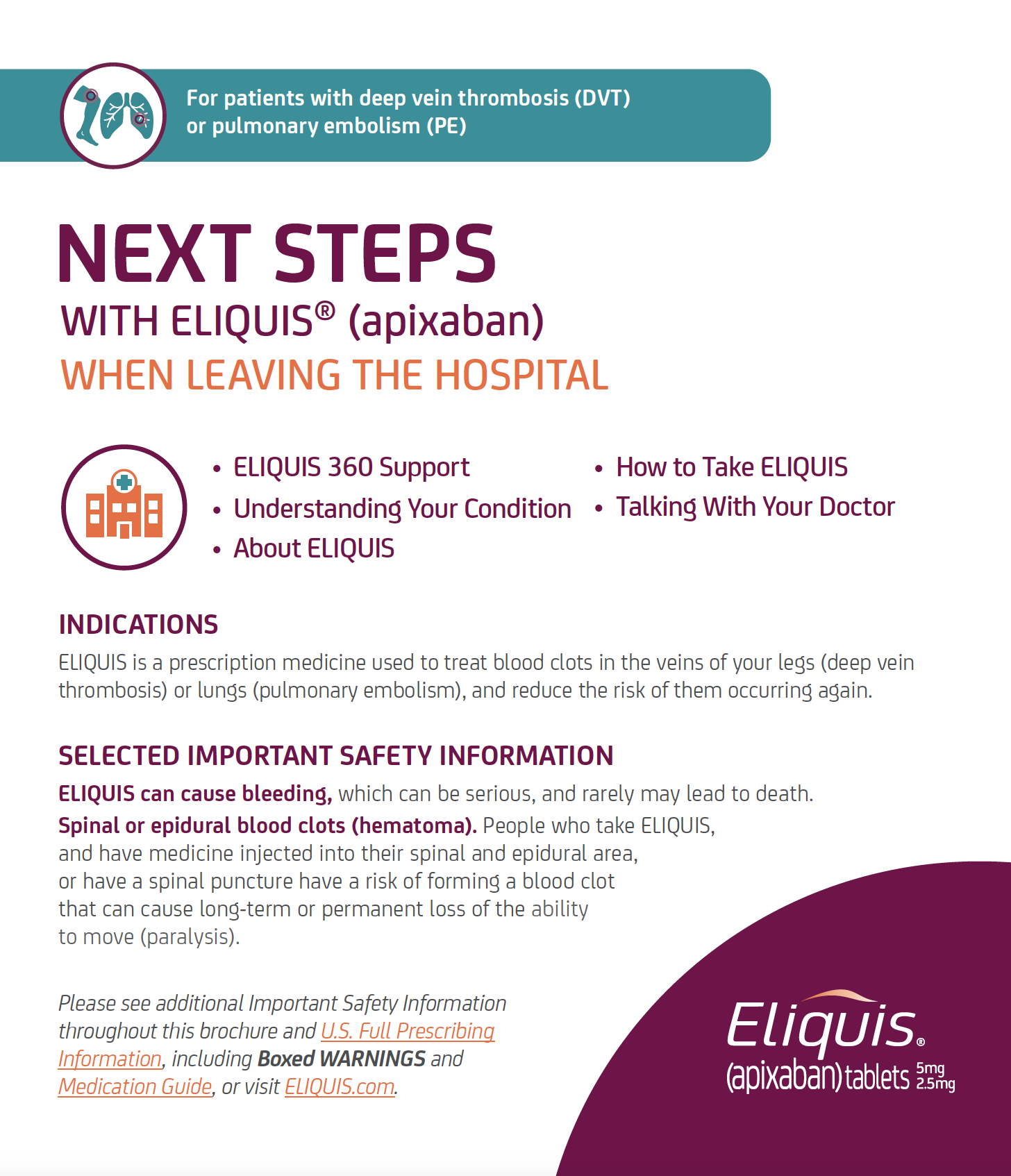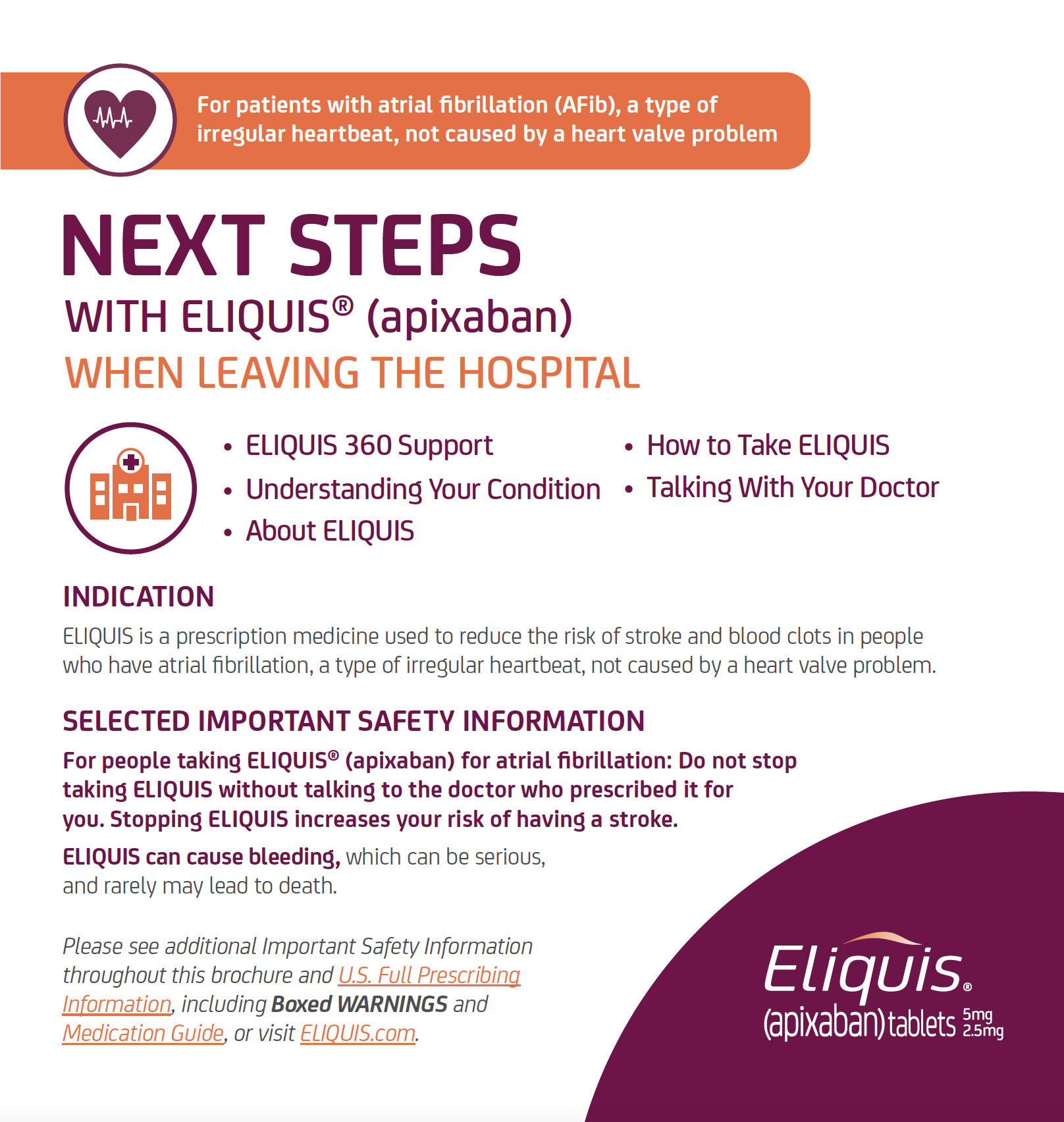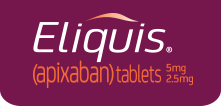ELIQUIS Hospital Hub Information and resources to support you and your staff
In patients with VTE, ELIQUIS demonstrated BOTH comparable efficacy AND superiority in major bleeding events vs enoxaparin/warfarin1



ELIQUIS increases the risk of bleeding and can cause serious, potentially fatal, bleeding.1
- Discontinuation rate due to bleeding events: 0.7% with ELIQUIS vs 1.7% with enoxaparin/warfarin
- In AMPLIFY, the most commonly observed adverse reactions in ELIQUIS-treated patients (incidence ≥1%) were epistaxis, contusion, hematuria, menorrhagia, hematoma, hemoptysis, rectal hemorrhage, and gingival bleeding
Consistent efficacy and rates of major bleeding across key patient subgroups2
Renal Impairment
Age
Weight
Gender
ARR=absolute risk reduction; CI=confidence interval; DVT=deep vein thrombosis; PE=pulmonary embolism; RR=relative risk; RRR=relative risk reduction.
*Recurrent symptomatic VTE (nonfatal DVT or nonfatal PE).
†Bleeding events associated with each endpoint were counted once per subject, but subjects may have contributed events to multiple endpoints.1
‡RRR was calculated as (1-RR) x 100. ARR is calculated as the difference between the incidences and is expressed as percentage points.
AMPLIFY Study Design
A randomized, double-blind, phase III trial to determine whether ELIQUIS was noninferior to enoxaparin/warfarin for the incidence of recurrent VTE* or VTE-related death in 5400 patients with objectively confirmed, symptomatic proximal DVT and/or PE. 2693 patients were randomized to ELIQUIS 10 mg orally twice daily for 7 days followed by 5 mg orally twice daily for 6 months, and 2707 patients were randomized to standard of care at the time, which was enoxaparin 1 mg/kg twice daily subcutaneously for at least 5 days (until INR ≥2) followed by warfarin (target INR range: 2.0–3.0) orally for 6 months. The primary efficacy endpoint was recurrent VTE* or VTE-related death, and the primary safety endpoint was major bleeding.1,2
≈90% of patients in the AMPLIFY trial had an unprovoked DVT/PE at baseline.1
- The 10% of patients with a provoked DVT/PE were required to have an additional ongoing risk factor in order to be randomized§
INR=international normalized ratio.
*Recurrent symptomatic VTE (nonfatal DVT or nonfatal PE).
§Risk factors included previous episode of DVT/PE, immobilization, history of cancer, active cancer, and known prothrombotic genotype.
Major bleeding was defined as clinically overt bleeding accompanied by one or more of the following2:
- A decrease in hemoglobin of ≥2 g/dL
- A transfusion of 2 or more units of packed red blood cells
- Bleeding that occurred in at least one of the following critical sites: intracranial, intraspinal, intraocular, pericardial, intra-articular, intramuscular with compartment syndrome, or retroperitoneal
- Fatal bleeding
AMPLIFY: a randomized, double-blind, phase III noninferiority trial1,2
Study objective: To determine whether ELIQUIS was noninferior to enoxaparin/warfarin for the incidence of recurrent VTE* or VTE-related death.1,2


- Primary efficacy endpoint: Recurrent VTE* or VTE-related death1,2
- Primary safety endpoint: Major bleeding2
DVT=deep vein thrombosis; INR=international normalized ratio; PE=pulmonary embolism.
*Recurrent symptomatic VTE (nonfatal DVT or nonfatal PE).
Select inclusion criteria: Objectively confirmed, symptomatic proximal DVT and/or PE.1
Select exclusion criteria1,2:
Patients who:
- Required thrombectomy, insertion of a caval filter, or use of a fibrinolytic agent
- Had cancer and for whom long-term treatment with low-molecular-weight heparin was planned
Patients with:
- A life expectancy of <6 months
- A creatinine clearance <25 mL/min
- Significant liver disease
- An existing heart valve
- Atrial fibrillation
- Active bleeding
Baseline characteristics: Approximately 90% of patients had an unprovoked DVT or PE at baseline, and 10% of patients with a provoked DVT or PE were required to have an additional ongoing risk factor, which included previous episode of DVT or PE, immobilization, history of cancer, active cancer, and known prothrombotic genotype. Patients were allowed to enter the study with or without prior parenteral anticoagulation (up to 48 hours).1,2
Major bleeding was defined as clinically overt bleeding accompanied by one or more of the following2:
- A decrease in hemoglobin of ≥2 g/dL
- A transfusion of 2 or more units of packed red blood cells
- Bleeding that occurred in at least one of the following critical sites: intracranial, intraspinal, intraocular, pericardial, intra-articular, intramuscular with compartment syndrome, or retroperitoneal
- Fatal bleeding
SUPERIOR

PRIMARY EFFICACY ENDPOINT
SIMILAR TO PLACEBO

PRIMARY SAFETY ENDPOINT
ELIQUIS increases the risk of bleeding and can cause serious, potentially fatal, bleeding.1
- Discontinuation rate due to bleeding events: 1.0% in ELIQUIS-treated patients vs 0.4% with placebo
- In AMPLIFY-EXT, the most commonly observed adverse reactions in ELIQUIS-treated patients (incidence ≥1%) were epistaxis, hematuria, hematoma, contusion, and gingival bleeding1
ARR=absolute risk reduction; CI=confidence interval; DVT=deep vein thrombosis; NS=nonsignificant; PE=pulmonary embolism; RR=relative risk; RRR=relative risk reduction.
*Recurrent symptomatic VTE (nonfatal DVT or nonfatal PE).
†Bleeding events associated with each endpoint were counted once per subject, but subjects may have contributed events to multiple endpoints.1
‡RRR was calculated as (1-RR) x 100. ARR is calculated as the difference between the incidences and is expressed as percentage points.
AMPLIFY-EXT Study Design
A randomized, double-blind, phase III trial to compare the efficacy and safety of ELIQUIS vs placebo in patients who had been treated for DVT and/or PE for 6 to 12 months with anticoagulation therapy without having a recurrent event, and for whom physicians were uncertain about continuing anticoagulation therapy. 1671 patients§ with objectively confirmed, symptomatic proximal DVT and/or PE were randomized to ELIQUIS 2.5 mg orally twice daily for 12 months (n=842) or placebo for 12 months (n=829). The primary efficacy endpoint was recurrent VTE* or all-cause death, and the primary safety endpoint was major bleeding.1,4
≈92% of patients in the AMPLIFY-EXT trial had an unprovoked DVT/PE at baseline.1
- The remaining 8% of patients had a provoked baseline event and one additional risk factor for recurrence
*Recurrent symptomatic VTE (nonfatal DVT or nonfatal PE).
§In AMPLIFY-EXT, 2486 patients were randomized, with 815 of these patients randomized to ELIQUIS 5 mg twice daily, which is not an approved dose for this indication.1,4
Major bleeding was defined as clinically overt bleeding accompanied by one or more of the following4:
- A decrease in hemoglobin of ≥2 g/dL
- A transfusion of 2 or more units of packed red blood cells
- Bleeding that occurred in at least one of the following critical sites: intracranial, intraspinal, intraocular, pericardial, intra-articular, intramuscular with compartment syndrome, or retroperitoneal
- Fatal bleeding
AMPLIFY-EXT: a randomized, double-blind, phase III trial1,4
Study objective: To compare the efficacy and safety of ELIQUIS vs placebo in patients who had been treated for DVT and/or PE for 6 to 12 months with anticoagulation therapy without having a recurrent event, and for whom physicians were uncertain about continuing anticoagulation therapy.1,4


- Primary efficacy endpoint: Recurrent VTE† or all-cause death1,4
- Primary safety endpoint: Major bleeding4
Why placebo?
The placebo arm simulates DVT/PE patients who would have received no further treatment after completing initial therapy.4
DVT=deep vein thrombosis; PE=pulmonary embolism.
*In AMPLIFY-EXT, 2486 patients were randomized, with 815 of these patients randomized to ELIQUIS 5 mg twice daily, which is not an approved dose for this indication.1,4
†Recurrent symptomatic VTE (nonfatal DVT or nonfatal PE).
Select inclusion criteria: Objectively confirmed, symptomatic proximal DVT and/or PE.4
Select exclusion criteria: Multiple episodes of unprovoked DVT or PE.1
Baseline characteristics:
- Patients had either an unprovoked DVT or PE at baseline (approximately 92%) or a provoked baseline event and one additional risk factor for recurrence (approximately 8%). Risk factors for recurrent VTE are: active cancer, persistent or permanent immobilization, previous DVT or PE, known prothrombotic genotype, or use of antiplatelet agents1,4
- Approximately one-third of patients participated in the AMPLIFY study prior to enrollment in AMPLIFY-EXT1
Major bleeding was defined as clinically overt bleeding accompanied by at least one of the following4:
- Hemoglobin decrease—A decrease in hemoglobin of ≥2 g/dL
- Transfusion—A transfusion of 2 or more units of packed red blood cells
- Critical site bleeding—Bleeding that occurred in at least one of the following critical sites: intracranial, intraspinal, intraocular, pericardial, intra-articular, intramuscular with compartment syndrome, or retroperitoneal
- Fatal bleeding
Select characteristics of randomized clinical trials
and
real-world data
clinical
trials
- Prospective design with prespecified, well-defined inclusion/exclusion criteria, outcomes, and endpoints5,6
- Patients are randomly assigned to treatment or comparator6
- Randomized clinical trials are designed to show causality (ie, efficacy and safety data)7
observational
studies
- Observational in nature and use data from routine clinical practice8
- Patients are not randomized5
- Can only evaluate association and therefore unable to determine causality5,8,9
Objectives and methods of analysis10
Objectives: To evaluate the following in patients with VTE treated with ELIQUIS or warfarin in the ED, with or without inpatient care following the ED encounter:
- VTE or major bleeding-related hospital readmissions* (inpatient or ED) during the 1-month period following the initial hospitalization or ED encounter
This analysis included outcomes that are not presented here.
Index event: First VTE ED visit
Index date: ED or hospital discharge date after the index event
Baseline period: 12 months prior to index event
Study design10
Retrospective observational study of the Premier Hospital database healthcare claims (from August 1, 2014, through May 31, 2018) for patients with VTE who were treated with ELIQUIS or warfarin in the ED, with or without inpatient care following the ED encounter.
The Premier Hospital database is a hospital drug utilization database in the United States. It contains complete billing and coding history for more than 8 million hospital readmissions per year (more than 25% of all inpatient admissions annually in the United States) and >765 million outpatient visits (ie, ED, ambulatory surgery centers, alternate sites of care for primary diagnosis) since 2012.
Statistical analysis10
- Multivariate logistic regression analysis was used to compare the likelihood of 1-month hospital readmission (ED or inpatient) in patients initially treated in the ED with ELIQUIS compared to warfarin, after adjusting for differences in patient characteristics
Specific characteristics adjusted for10:
- Age, gender, race, payer type, Charlson Comorbidities Index score group, prior VTE diagnosis in the baseline period, prior bleeding diagnosis in the baseline period, index event VTE type, and hospital characteristics (geographic region, urban/rural location, teaching status, and bed size)
Subgroup analyses10
Subgroup analyses of the adjusted outcomes of major bleeding-related and VTE-related 30-day readmissions were additionally conducted for study subpopulations that included:
- Patients with an index ED visit only without inpatient admission
- ED patients admitted to the inpatient setting
Inclusion criteria10
- Patients aged ≥18 with an ED visit with a primary discharge diagnosis code of VTE
- Primary discharge diagnosis of VTE identified by ICD-9-CM or ICD-10-CM codes from the Premier Hospital database from August 1, 2014, through May 31, 2018
-
Patients who received ELIQUIS or warfarin for the treatment
of VTE during ED encounter
- Patients treated with warfarin were additionally required to have received ≥1 injectable anticoagulant, including LMWH, UFH, or fondaparinux, during ED visits
- Patients treated with ELIQUIS included those with or without injectable anticoagulant usage
Exclusion criteria10
During index event:
- Patients who received treatment with both ELIQUIS and warfarin
- Patients treated with a DOAC other than ELIQUIS, such as XARELTO, PRADAXA, or SAVAYSA
- Patients who were transferred from other facilities or died during the index events
12 months prior to index event or during index event:
- Primary or secondary diagnosis code for atrial fibrillation/atrial flutter, or pregnancy
- Records of inferior vena cava filter usage
Xarelto(r) (rivaroxaban) is a registered trademark of Bayer Aktiengesellschaft. Pradaxa (r) (dabigatran etexilate) is a registered trademark of Boehringer Ingelheim Pharma GmbH & Co KG. Savaysa (r) (edoxaban) is a registered trademark of Daiichi Sankyo, Inc.
Patient flow in the 2 study cohorts10


Study considerations and select limitations10
- Due to the nature of retrospective observational studies, no causal relationship between the OAC treatment and outcomes could be concluded
- Premier Hospital database did not include data about outpatient use of OACs or other medications post-hospital visit (including post-ED direct discharge)
- Findings may not have been generalizable to the entire US population of patients with VTE in a hospital setting
- Administrative hospital data collected for purposes other than research and analysis are subject to inherent limitations due to constraints of diagnostic codes, potential coding errors, and missing data
- Because this study was based on claims data and because patients were not randomized to treatments, despite adjustment for observed confounding factors, an imbalance of unobserved variables between treatment arms could have resulted in residual confounding
- Only readmissions to the same hospital or hospital system within the Premier network could have been identified in the database. This may have led to an underestimation of the readmission rates
- In this analysis, VTE-related readmissions were defined as hospital readmissions (including subsequent ED visits or inpatient admissions), with the corresponding primary discharge ICD-9/ICD-10 diagnosis codes. These VTE-related readmissions may not all have been VTE recurrences
- VTE or bleeding-related deaths were not assessed in this analysis
- The duration and dosage of an injectable anticoagulant required for study inclusion for patients treated with warfarin or allowed for patients treated with ELIQUIS were not recorded in the database or assessed
- Utilization of outpatient routine monitoring among patients who were treated with warfarin was not evaluated in this analysis
- This analysis was funded by Pfizer Inc. and Bristol Myers Squibb. Some of the authors of the publication have received compensation from or have an affiliation with Pfizer Inc. and/or Bristol Myers Squibb
Identification of VTE ICD code categories11
The ICD-9-CM and ICD-10-CM codes used for the diagnosis of VTE included the following main categories:
- PE and infarction (except due to sepsis)
- Phlebitis and thrombophlebitis of deep veins of lower extremities
- Other acute venous embolism and thrombosis of deep vessels of lower extremities
There were patients included in the study who had codes other than the above, for phlebitis and thrombophlebitis or other venous embolism or thrombosis that involved:
- Superficial vessels
- Vessels of the upper extremities or of other sites
Select patient characteristics10†
| ELIQUIS n=12,174 |
WARFARIN n=27,767 |
|
|---|---|---|
| Demographics | ||
| Age, mean (SD) | 59.7 (17.0) | 59.3 (17.2) |
| Gender, Female, n (%) | 6139 (50.4) | 13,752 (49.5) |
| CHARLSON COMORBIDITY INDEX, MEAN (SD) | 1.0 (1.8) | 1.3 (2.0) |
| COMORBIDITIES AT INITIAL VTE ED EVENT, N (%) | ||
| Hypertension | 5340 (43.9) | 14,068 (50.7) |
| Diabetes | 2015 (16.6) | 5552 (20.0) |
| Peripheral vascular disease | 1333 (11.0) | 3967 (14.3) |
| Coronary artery disease | 1167 (9.6) | 3451 (12.4) |
| PRIOR VTE DIAGNOSIS IN THE BASELINE PERIOD, N (%) | 1215 (10.0) | 3270 (11.8) |
| PRIOR ANY BLEEDING DIAGNOSIS IN THE BASELINE PERIOD, N (%) | 165 (1.4) | 460 (1.7) |
| PRIMARY DIAGNOSIS VTE TYPE, N (%) | ||
| DVT | 8809 (72.4) | 15,966 (57.5) |
| PE | 3365 (27.6) | 11,801 (42.5) |
DOAC=direct oral anticoagulant; ICD-9-CM=International Classification of Diseases, Ninth Revision, Clinical Modification; ICD-10-CM=International Classification of Diseases, Tenth Revision, Clinical Modification; LMWH=low-molecular-weight heparin; UFH=unfractionated heparin, SD=standard deviation.
*Major bleeding-related and VTE-related readmissions were defined as readmissions with a corresponding primary discharge ICD-9/ICD-10 diagnosis code.
†Patient demographics and clinical characteristics were evaluated during the index event; prior VTE and any bleeding diagnoses were measured during the 12-month baseline period.
Select characteristics of randomized clinical trials
and
real-world data
clinical
trials
- Prospective design with prespecified, well-defined inclusion/exclusion criteria, outcomes, and endpoints5,6
- Patients are randomly assigned to treatment or comparator6
- Randomized clinical trials are designed to show causality (ie, efficacy and safety data)7
observational
studies
- Observational in nature and use data from routine clinical practice8
- Patients are not randomized5
- Can only evaluate association and therefore unable to determine causality5,8,9
Observational retrospective analyses are not intended for direct comparison with clinical trials and are designed to evaluate associations among variables; causality cannot be established in observational analyes.9
The general study design, including the definitions of VTE and bleeding-related outcomes, the follow-up period, and the patient population in AMPLIFY were different than in the analysis. AMPLIFY included “VTE-related death” in the efficacy analysis, which could not be evaluated in this analysis.2,10


ELIQUIS increases the risk of bleeding and can cause serious, potentially fatal, bleeding.1
Secondary outcome: Subgroups analyses of patients with an initial VTE ED visit only and ED patients admitted to the inpatient setting


ELIQUIS increases the risk of bleeding and can cause serious, potentially fatal, bleeding.1


ELIQUIS increases the risk of bleeding and can cause serious, potentially fatal, bleeding.1
CI=confidence interval; ED=emergency department; ICD=International Classification of Diseases; OR=odds ratio.
*Major bleeding-related and VTE-related readmissions were defined as readmissions with a corresponding primary discharge ICD-9/ICD-10 diagnosis code.
†With or without inpatient care following the initial ED encounter.
‡Readmission rates are unadjusted.
§Readmission included ED visits and inpatient admissions.
||ORs have been adjusted for confounding factors.
Access clinical trial and dosing information
Learn more about the studies used in ELIQUIS clinical trials.
Treatment for patients with DVT/PE1

ELIQUIS is the #1 prescribed OAC in new patient starts for the treatment of VTE12*
*Based on SHA PP SoB. OAC prescriptions were written by all specialties and filled by patients who did not have any prescriptions filled for any OAC in the previous 6 months. Claim valid as of 11/6/23.
See the dosing regimen for patients
with DVT/PE1
Reduction in risk of
stroke/systemic embolism in NVAF1

ELIQUIS is the #1 prescribed OAC among cardiologists12†
†Based on SHA (PHAST) Total Prescription
Database (TRx). OAC prescriptions were written by
cardiologists and filled by patients. Claims valid as of
2/5/24.
Get dosing information for patients
with NVAF1
Want a dosing guide on your desktopfor all ELIQUIS indications?
Discharge resources
These resources were developed to help support you and your patients with DVT/PE or NVAF at discharge.

VTE Discharge Kit
Help your patients get started on ELIQUIS for the treatment of DVT/PE.

NVAF Discharge Kit
Help your patients with NVAF get started on ELIQUIS to reduce the risk of stroke.
Patient support tools
Get tools and resources to help support your patients on ELIQUIS.

Find ELIQUIS coverage
information for your area
References
- ELIQUIS® (apixaban) Package Insert. Bristol-Myers Squibb Company, Princeton, NJ, and Pfizer Inc, New York, NY.
- Agnelli G, Buller HR, Cohen A, et al for the AMPLIFY Investigators. Oral apixaban for the treatment of acute venous thromboembolism. N Engl J Med. 2013;369(9):799-808. Supplement available at http://www.nejm.org/doi/suppl/10.1056/NEJMoa1302507/suppl_file/nejmoa1302507_appendix.pdf. Accessed November 2022.
- Agnelli G, Buller HR, Cohen A, et al. Oral apixaban for the treatment of venous thromboembolism in cancer patients: results from the AMPLIFY trial. J Thromb Haemost. 2015;13:2187-2191.
- Agnelli G, Buller HR, Cohen A, et al for the AMPLIFY-EXT Investigators. Apixaban for the extended treatment of venous thromboembolism. N Engl J Med. 2013;368(8):699-708. Supplement available at http://www.nejm.org/doi/suppl/10.1056/NEJMoa1207541/suppl_file/nejmoa1207541_appendix.pdf. Accessed November 2022.
- Hannan EL. Randomized clinical trials and observational studies: guidelines for assessing respective strengths and limitations. JACC Cardiovasc Interv. 2008;1(3):211-217. doi:10.1016/j.jcin.2008.01.008
- Stanley K. Design of randomized controlled trials. Circulation. 2007;115(9):1164-1169. doi:0.1161/CIRCULATIONAHA.105.594945
- Kovesdy CP, Kalantar-Zadeh K. Observational studies versus randomized controlled trials: avenues to causal inference in nephrology. Adv Chronic Kidney Dis. 2012;19(1):11-18. doi:10.1053/j.ackd.2011.09.004
- Garrison LP Jr, Neumann PJ, Erickson P, Marshall D, Mullins CD. Using real-world data for coverage and payment decisions: the ISPOR Real-World Data Task Force report. Value Health. 2007;10(5):326-335. doi:10.1111/j.1524-4733.2007.00186.x
- Silverman SL. From randomized controlled trials to observational studies. Am J Med. 2009;122(2):114-120. doi:10.1016/j.amjmed.2008.09.030
- Deitelzweig S, Hlavacek P, Mardekian J, et al. Comparison of inpatient admission rates of patients treated with apixaban vs warfarin for venous thromboembolism in the emergency department. Hosp Pract. 2020;48(1):41-48. doi:10.1080/21548331.2020.1718925.
- Deitelzweig S, Hlavacek P, Mardekian J, et al. Comparison of inpatient admission rates of patients treated with apixaban vs warfarin for venous thromboembolism in the emergency department. Hosp Pract. 2020;48(suppl):S11-S14. doi:10.1080/21548331.2020.1718925.
- Data on File: ELQ Market Share. Bristol-Myers Squibb Company, Princeton, NJ.




.jpg)


